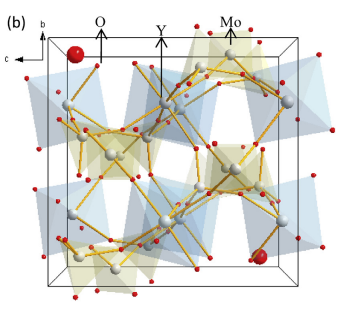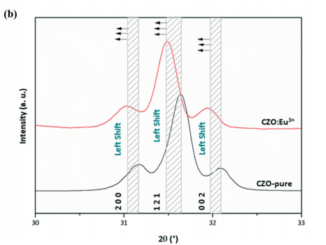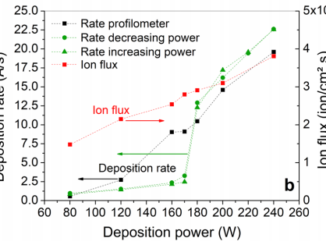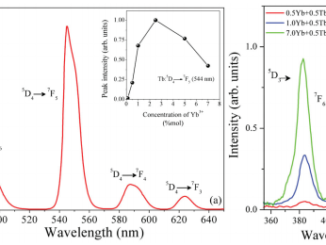
Red phosphor based on Eu3+-doped Y-2(MoO4)(3) incorporated with Au NPs synthesized via Pechini’s method
Abstract: Structural, morphological and spectroscopic characterization of the Eu3+-doped Y-2(MoO4)(3) red phosphor incorporated with Au nanoparticles (Au NPs) synthesized via Pechini’s method is reported in the present study. In order to evaluate the Au NPs and Eu3+ ions influence on the molybdate structure, the Y-2(MoO4)(3), Y-2(MoO4)(3):Eu3+, Y-2(MoO4)(3)/Au and Y-2(MoO4)(3):Eu3+/Au samples were produced and fully investigated. All samples obtained at relatively low temperature, i.e., 650 degrees C, show molybdate as the unique phase with high crystallinity assisted by both Eu3+ ions and Au NPs. Water molecules detected in the molybdate structure probably are distorting MoO4, YO6 and EuO6 polyhedra similarly to the Au NPs incorporated in the same lattice. These Au NPs are spherical-shaped with a diameter near to 46 nm and they are located on the molybdate particle surface. The Eu3+-doped phosphors, with or without the presence of Au NPs, exhibit intense red luminescence characteristic of the Eu3+ ion inserted in low-symmetry sites. However, the Au NPs increase the radiative emission rate and absolute quantum yield of the Eu3+ D-s(o) emitter state due to the excitation field enhancement caused by the local surface plasmon resonance absorption effect of gold nanoparticles, which was confirmed by diffuse reflectance measurements. Finally, the Eu3+ quantum efficiency enhancement to 92% played by the gold nanoparticles and the high red color purity qualify the obtained phosphor for photonic applications.
Author(s): Bispo, AG; Shinohara, GMM; Pires, AM; Cardoso, CX
OPTICAL MATERIALS
Volume: 84 Pages: 137-145 Published: OCT 2018
DOI: 10.1016/j.optmat.2018.06.023




